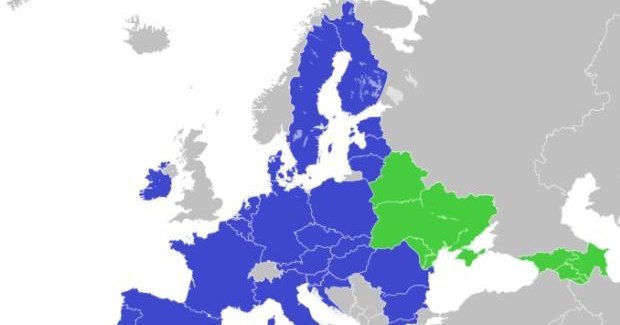The Eastern Partnership, launched by the EU in 2009, governs the relationship between the EU and the post-Soviet countries of Armenia, Azerbaijan, Belarus (who suspended their participation in 2021), Georgia, Moldova, and Ukraine. Harjeet Singh discusses the impact of the Eastern Partnership on EU relations with Russia in the context of the war in Ukraine, and the future of the agreement for Eastern Europe.
Normative powers and neorealist regimes cannot be brought to the same negotiation table. It invites jargon and superficiality of theories that may hamper the possibility of a common working goal. When the Soviet Union was dismantled, the EU took the opportunity to advance shared goals by suggesting a framework concerned with political liberty and economic integration. However, it will be a mammoth mistake not to accommodate the militaristic development of the European Union through NATO expansion.
The Eastern Partnership The Eastern Neighborhood Policy and Eastern Partnership paved the way for EU integration. The “Euromaidan” revolution entertained as a coup d’état where Western leaders with the same principles, such as democracy, foment that liberal coup. Yanukovych rejected the EU-rigid deal, expressing that the trade-off with the EU will cost Russian partnership. Simultaneously, the deal was significantly inadequate to ameliorate the Ukrainian economy to European standards. Russia’s perspective is, since the Euromaidan has changed drastically, according to political scientist Professor John Mearsheimer: Russian actions are the repercussions of EU expansion first by economic partnerships then the military. The bilateral agreement enables Russia to draft deals such as the Nord Gas pipeline, where aspects such as human rights and governance are minimal. At the same time, the pragmatic approach serves the interests of both parties. The Eastern Partnership and Ukraine The Russian invasion of Ukraine shattered all the plans of EU membership. Simultaneously, the speculation over NATO membership - which is the fruit of “aggressive normative policy” - is the direct reaction of normative policies of the EU at the cost of strategic interest, questioning the governance of the Kremlin entertained as an attempt at regime change - a reason for suspicion, especially in the light of the 2014 Coup. The Kremlin began looking toward China from 2014 and makes a significant contribution in the geopolitical realm due to the belligerent nature of the EU, shifting geopolitics towards the dichotomy of West and non-Western nations by outrightly rejecting Eurocentric norms as it alienates the concept of independent state affairs.
The weakness in the Eastern European partnership could be comprehended by the diverse approaches of hegemonic powers, namely Russia and the European Union. The establishment of EaP was understood by Russia to be a warning signal, especially after the Bucharest summit of the Northern Atlantic Treaty Organization, where the aspirations of Georgia and Ukraine as potential candidates for NATO membership were acknowledged, before the Russian invasion of Georgia in the following months. The Ukrainians opted for the Associated Agreement after 2014, which according to the European Union, was the initial step towards the membership facilitated by the visa-free regime and comprehensive free trade agreements to attain “European Standards”. However, if we examine the partnership under EaP, one major flaw is that no major institutional change except the emergence of civil society has been realized. Despite the enormous grants and allocation of money to the EaP, local leaders have not been strengthened to European standards, leading to migration from EaP countries towards Europe, especially in the case of Armenia, where 2/3 of the population are working abroad. The second issue alongside corrupt institutions is the radical normative approach where standards are entertained as the core of any dialogue for the European Union: this is confirmed by Article 49 of the Maastricht Treaty of 1992, where alignment with Article 2 of TEU is mandatory for membership.
In contrast, the Russian approach is more regional hegemonic, where sovereignty and self-interest were the primary goals recognized in forming the Eurasian Economic Union in 2015. The future of EaP in light of the war in Ukraine is a problem to anticipate, as the inefficiency to counter Russian aggression might dissuade partners from risking their sovereignty by seeking membership when the European Union could not provide security assurance. The inclination of Eastern European countries is to avoid hegemonic Russian influence. Furthermore, the complex and uncertain path for European membership, which is the primary goal for Eastern partners, is unforeseeable in the near future, like Turkey, which has been grappling with the task of EU membership for the last three decades. The threat of Russia will shape the EaP even after the sanction’s regime against the Kremlin because in the absence of Russia, the concept of balancing the EaP will not prevail, yet the red pill for the EU is to negotiate on realistic issues, not on normative.
Russia’s aims
The idea of the common neighborhood can only be realized when some compromise between the European Union and Russia materializes. The European Union must negotiate not from the normative perspective but a practical approach taking into consideration the aspirations of Russia in the region. Looking at the Russian proposal of December 2021, the Kremlin sought a neutral Ukraine, especially in the Eastern Ukraine region, which is dominated by a Russian speaking population who outrightly rejected the EU deal back in 2014. That is now untenable and will eventually end up in a zero-sum game especially taking into consideration the prospect of the continent where Russian aggression towards Ukraine, because of their aspirations for European Union membership, ignited regional tensions between the European Union and Russia, especially in Eastern Europe. This echoed the need for a pragmatic approach of providing Russia with security guarantees and demilitarizing Eastern Europe, which the EU declined in December 2021. This was feasible back then, but is now hard to realize.
Simultaneously, if the European Union compromises on its normative power, which is the centerpiece of the European Union structure, in that case, it will empower those countries on the backsliding, such as Poland and Hungary facing criticism because of their shortfall on European standards on human rights and governance. This dilemma fractured the Eastern Partnership, where Brussels either lowered their values to accommodate Russia or embraced the unshakable values that put Eastern Europe under the possible threat of Westward invasion as Russia sought the all-out campaign in Ukraine. The only way to approach Russia is to provide a legally binding security guarantee to Russia and the Eastern European States, as the Russo-Ukraine war will probably end up in a stalemate, allowing the EU the option to isolate Russia and leave the possibility of future invasion open, or entertain Russia and dismantle its hegemonic powers through institutions. In the rift between these two hegemonic powers, no independent and feasible decision could be manifested if one hegemon is excluded from the discourse of deliberation, especially in the economic partnership, where Eastern countries who were abandoned without arms and ammunition are to engage with EU economic integration initiatives, such as the Eastern Partnership.


Follow the comments: |
|
